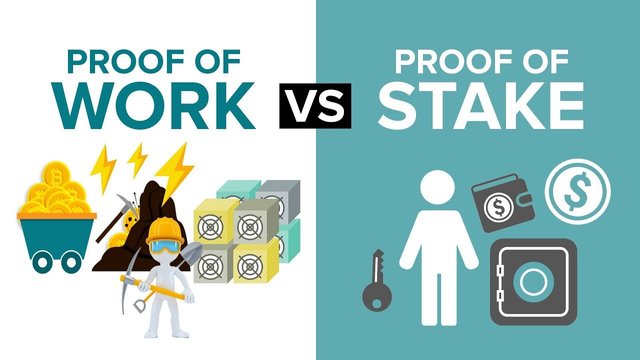
Questions to be answered
what is the difference between PoW and PoS?
Advantages and Disadvantages of PoW and PoS?
which one is better in scaling capacity? Examples?

what is the difference between PoW and PoS?

Proof of Work:
Proof of work is a system that needs a certain amount of work power for the establishment of blocks on a blockchain system. It is a decentralized system that survives on the work done by the nodes on the system, which usually involves solving mathematical problems that will in turn prevent anyone from taking advantage of the system through malicious activities.
The Proof of work system was properly introduced in 2009 with the launch of Bitcoin, and the genius behind this consensus algorithm is Hal Finney. The system caries out transaction verification by conducting hashing rounds, where nodes on the system strive to "win" a hash, and when a node does, it is allowed to have it's transaction recorded on the blockchain, and in a truly transparent and honest manner, that every node can see the records of the transactions also.
Proof of Stake:
The Proof of Stake system is one that condones mining by nodes that have coins or tokens associated with the system, and the more coins or tokens a user or node of the system possesses, the stronger and faster they become in mining. In simpler terms, the more coins a user or node has, the more influential they are in that blockchain system because they can now mine faster and more effectively than others with lower stakes.

Differences between PoW and PoS


| PROOF OF WORK | PROOF OF STAKE |
|---|---|
| The Proof of work Rewards according to amount of work done on the blockchain system | The Proof of stake Rewards according to the amount of tokens or coins held by nodes on the blockchain system |
| Competition to mine is highly affected by mining instruments like high level technology computers | mining is highly influenced by number of coins being held by the node or user. |
| There is high competition to mine a new block as miners steadily strive to complete calculations first with high-tech computers | There is almost no competition as the algorithm rewards based on the amount held by a stake holder associated with the block creation. |
| Proof of Work rewards miners for getting the hash first with what is known as block rewards. | In Proof of Stake, the miners are rewarded by the transaction fees accumulated during mining. |
| In order for a malicious node to takeover the system, he has to possess at least 51% of the working computers on the blockchain system | In order for a malicious node to takeover the system, he has to possess at least 51% of crypto coins available on the blockchain system. |
| Uses a lot of power for mining purposes | Uses little or no power to mine blocks |

Advantages and Disadvantages of PoW and PoS?

Tested and Trusted:
The Proof of work consensus algorithm was the first ever of it's kind to actually be put to use in a blockchain system, with the launch of Bitcoin in 2009, and despite the trials that Bitcoin blockchain has gone through, the system has still shown it is reliable. This is a characteristic that not many consensus algorithms have in common, and it just goes on to show how reliable the system is.Great reward system for miners:
On the Proof of Work, miners are rewarded with block rewards together with transfer fees derived while mining the block, this ensures that miners are kept motivated to work even harder on the system. Even though these rewards go through halving, the rewards are still pretty much as valuable because of the appreciation in price of the coins.Proof of Work projects give birth to new projects:
Because of how reliable the proof of work consensus is, new forks and projects are birthed from the projects that use the proof of work, even though most ties these projects don't use the proof of work themselves. Taking bitcoin as an example, we can see how many forks it has birthed, and how many crypto projects have sprung up from it's consensus algorithm.Secure:
The Proof of work algorithm has proven to be secure, with it's several verification procedures, even though there has been incidences of hacking, the transparency of actual transactions and block mining has not been faltered or questioned. The proof of work system is hard to hack too, because there are so many working nodes trying to verify the legitimacy of transactions on the system.
Energy consuming:
The proof of work algorithm uses huge amounts of energy for mining, and most of this energy ends up as waste after the block has been successfully mined. Huge computers are used , which need high electricity supply and space, and some other factors. This is not favorable to everybody, as in general, high energy consumption is not good for the ecosystem. Imagine a mining farm with several hundreds of highly powerful super computers, to power these devices alone will be very tasking, and emissions from such machines are not helpful to theMining / block rewards reduces with time:
Taking an example from the proof of work system in the Bitcoin Blockchain, we can notice how less blocks were mined over the years, this is associated with the discouraging reduce in block rewards probably, and the fact that the block rewards, reduces after a 4 year period. This is usually to ensure that there is a control of total circulation of bitcoin.Costly to maintain:
The proof of work requires fast computers which are expensive to purchase and maintain. The computers are also pretty voluminous and require space, and this in turn increases cost of the algorithm maintenance. This is usually driven by the healthy competition to mine on the blockchain system, because with the release of newer and more capable devices, the miners would want to have the best out there, and will look forward to getting more of these expensive devices.
Eco-friendly:
The Proof of stake unlike the Proof of work does not require high level machines which exhume wasteful products that are harmful to the environment. Instead, it is run by nodes that are invested into the blockchain system by means of possessing the coins that are associated with the blockchain. This system ensures that there is no need for high carbon wastage like what the bitcoin Proof of work is currently thriving on.Cost effective in the terms of materials needed:
The Proof Of Stake as you might have guessed, doesn't require high-tech computers for maintenance of the system, it is cost effective in this aspect, as it also usually provides the option of joining staking pools for nodes who might not be able to acquire much of the coins needed to qualify to mine on the blockchain. This means that it is easier for a node to survive on the Proof of Stake based system because if it can not surmount enough coins to stake, it is presented with the option of staking pools.It is More Decentralized:
The fact that the Proof of stake algorithm is run by staking of coins, it means that each node actually has it's own percentage of participation on the system, Which in turn shows how decentralized this system is, Everyone has a stake, unlike the Proof of work, that nodes with smaller facilities have slim chances of mining a block, which in turn discourages mining participation.
Not tested enough:
Compared to the Proof of Work, The proof of stake is relatively newer, and has not been tested as much, this leaves the question of how secure and stable the system is. There have been cases of nodes being overthrown due to loss of keys or hacking in some blockchain, newer problems might arise which might be too much for the system, but i am not insinuating that the Proof of work is invincible, I am implying that the proof of stake is still a tad younger, and this is a disadvantage in itself because the more time a consensus algorithm is tested, the more it gains acceptance.Nothing at stake issue:
There is an issue known as the "nothing at stake" though it rarely happens, but it happens when two blocks are made almost at the same time, usually because of a time lag in the system. This is dealt with by the system as nodes are then forced to choose which of the blocks is valid, this in turn makes nodes go into creating blocks for other forks, forcing them to lose up on other opportunities.

which one is better in scaling capacity? Examples?

Scaling capacity or scalability in literal terms refers to the capability of a system to condone more work without breaking or failing. It could be seen as a test for elasticity of a system, so bringing it back to the blockchain context, scalability can be seen as the ability for the said system to carry out more events or transactions with time. This is important to note, because we can see it as a speed test of a system, and now we have to discover which one between the Proof of Work and the Proof of Stake which has more scalability.
Going unto the scalability of Bitcoin (it is a proof of work based blockchain) we can see that it is recorded that the system can handle between 3.3 to 7 transactions per second which is relatively poor. Bitcoin is not the most scalable proof of work Blockchain out there but it shows that the proof of work algorithm is generally not as scalable as the Proof of stake which has projects like the BNB which can handle 1.4 million transactions per second. So it is pretty clear that the Proof of stake is more scalable, probably because of the many verification steps present in the proof of work algorithm.
| Proof of Work projects | Proof of Stake projects |
|---|---|
| Bitcoin | BNB |
| Dash | Flow token |
| litecoin | AKT token |
| Primecoin | Ethereum |
| zencash token | Raydium |
| Vertcoin | tezos |

CONCLUSION

The consensus algorithms are like the backbones of the blockchain system, and the blockchains are also highly characterized by the algorithms they run in order to achieve consensus. This is just to establish the importance of the consensus algorithm in the decentralization of finance, and in this article we concentrated mostly on the proof of work and the proof of stake which are pretty much the two pioneers of consensus algorithms. i talked about the brief history of the proof of work, the differences between the two, their pros and their cons. This article was enjoyable to create, and i hope i have satisfactorily explained the needed answers to the questions asked.
Hi @rexxalo, Thank you for taking interest in the 4th Task of the Beginners Fixed Class. Your grades are as follows:
My Review and Suggestions:
You have completed the task.
You created an article with a very good structure, great work!!
Use function bold for some words that need to be highlighted.
There are some grammatical errors, please pay attention to grammar before posting.
Vary headers and sub-headers to make them look more attractive.
Thank you!
Downvoting a post can decrease pending rewards and make it less visible. Common reasons:
Submit